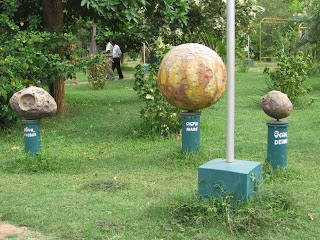 As good a picture I could get of the actual edicts.
As good a picture I could get of the actual edicts.
The Peace Pagoda:

When I arrived at the Peace Pagoda the man on the left in the next picture came up to me and started grunting and using hand gestures to tell me about the different gods at the temple. I don't know why he didn't speak, even Hindi or Oriya, but it was amazing how much he could communicate using body language and hand gestures. He showed me how to honor each of the gods and did a little blessing for me in front of each of the idols.

In fact, in front of the next god, he asked me the names of my parents to give them blessings. He asked if I was married, I replied no. He asked if I had a boyfriend that was "with my life". I replied yes and he gave me this string bracelet to bring back to Matt if "I wanted him for improvements". I believe what he meant was that I should give Matt this bracelet if I wanted good things to come to him. Of course, the broken english could mean anything, but that's what I'm taking it to mean!


After the Peace Pagoda I took an hour long ride down to Konark to see the Sun Temple. Unfortunately because of how the timing worked I was there during the hottest part of the day...not very smart. So, it was not a very enjoyable experience even though the temple itself was really amazing. The second I stepped out of the car a man approached me offering his services as a tour guide. I knew from my trusty Lonely Planet that a guide was necessary because otherwise you'd have no idea what you were looking at, but to make sure to get a licensed, official guide. The man immediately pulled out a business card saying he was official, but I couldn't help but feel like I wouldn't ever know if it was real or not. Thankfully, he offered to give me an introduction before I agreed to hire him. Official or not, he was a really good guide!
The Sun Temple is one of the most popular tourist sights in Orissa mainly because it's not actually a temple - it's only a monument. The temple was built by King Narasimhadeva I. The story is that he had a son by a woman but didn't know it. When the grown son came to him the King denied him as a son and the boy dove off the top of the temple into the sea, killing himself. This was seen as a bad omen and the King decided to never open the temple for worship.

The entire temple is made of sandstone, and this sculpture greets you at the entrance. The lion and elephant are crushing man - implying to leave your pride at the door.

Every inch of the outdoor temple is carved in such intrecate designs.

Many of the designs are of musicians, gods, women, animals, warriors, etc.

One of the most remarkable aspects of this temple is all that it's survived. It was almost completely destroyed by the Muslims and then by 2 cyclones. The government of India has worked to restore most of the structures, but they have left some of the broken pieces out as a reminder of what the temple has endured. This picture is what used to be the very top of the temple.

The temple is designed as a huge chariot with 24 huge wheels and 7 horses, all carved out of sandstone.

The temple is probably most famous for all of the erotic sculptures that are mixed in with the animals, musicians, and everyday activities. Just a few examples, the next sculpture is of lesbians.

The reason behind all the erotica is that when the temple was constructed there had just been a great war and the population was sparse. In order to booster population, the King decided to encourage sexual acts by putting them in plain sight on the temple architecture. I can't find anything to support this argument, but it's what my guide told me.

In this aspect, my guide was very good. I met an American girl who is here in Bhubaneswar doing an internship with UNICEF who went to the museum with a few other girls and who's guide was so embarrased showing them the sculptures that he basically just pointed at them and walked ahead. My guide was very funny actually, and would point and say "lesbians, do you see?" "see, this one monogamous, and this one polygamous...see all the ladies?" It was quite amusing.
All in all, it was a great day. Long and exhausting, but also interesting and more fun than I've had other days exploring by myself. At the end of the day I was so tired and gross from sweat and sunscreen that I went to eat at one of my favorite "chaat" restaurants near my hotel. Chaat means snack, although they seem to serve regular food. My favorite dish in India is by far the rava masala dosa. It's served with sambar (the tomatoey stew type sauce on the bottom), coconut chutney, and garlic chutney. mmmm. It's really too bad they don't serve these in the States...maybe I'm going to have to look harder.








































